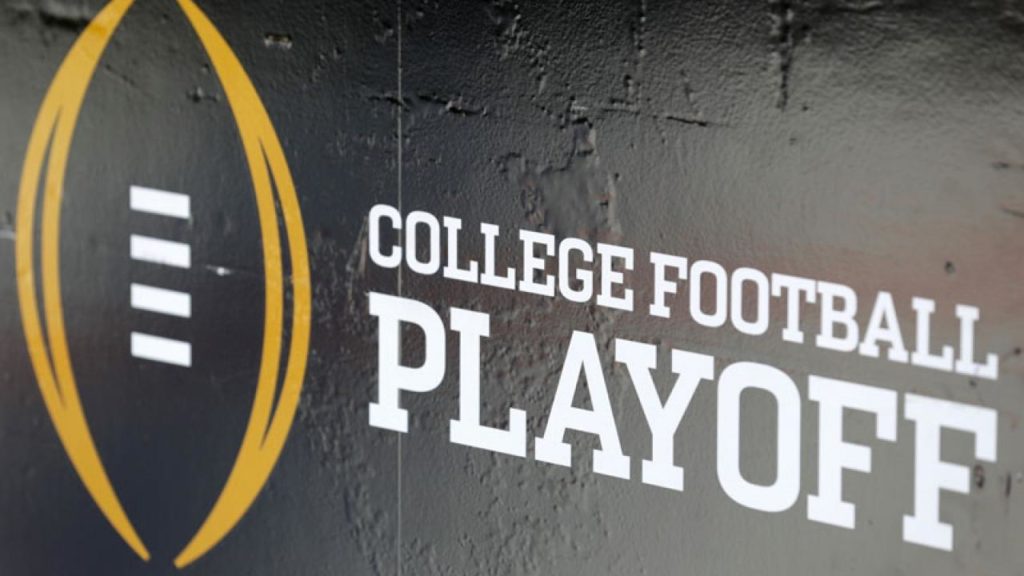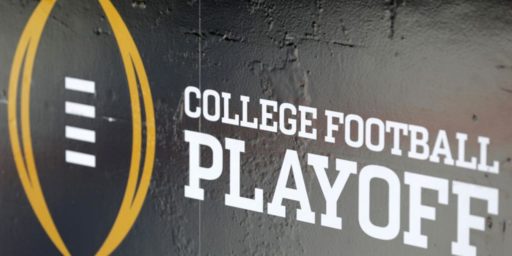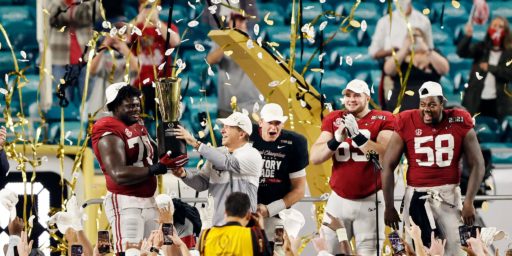College Football Playoff Expansion
The inevitable is now very much in progress.

For most of its history, the top level of college football lacked a national championship. Teams would compete against others for conference titles and bowl trophies. Eventually, various polls arose to declare notional national champions. These were sometimes split between polls and almost always the subject of hot debate. Finally, in 1992, a Bowl Coalition arose, with the purpose of ensuring that the top two-ranked teams going into the bowl season would face off against one another to decide a “true” champion. It lasted just three seasons before being tweaked into a Bowl Alliance and then a Bowl Championship Series, which expanded the number of conferences involved and ensured that the premium bowl games were able to land top teams.
Finally, in 2014, we got the College Football Playoff. It would put the #1 and #4 and #2 and #3 teams against one another in bowl games and then the winners of those semifinal games would face each other for the national championship. It was, by most accounts, an improvement over the BCS and, certainly, the old poll system. But it has major issues. By definition, at least one Power Five conference champion will be left on the outside. In the eight years thus far, no school from outside the Power Five has made it in and the odds are that none ever would. At the same time, four teams—Alabama, Clemson, Ohio State, and Oklahoma—have dominated the selection process, with all of the championships won by the first three or Louisiana State (in their only year in the playoff). Indeed, Alabama has won three and Clemson two of the seven, with Ohio State and LSU accounting for the other two.
Further, as widely predicted, the Playoff has become the only thing that matters. The other bowls have been relegated to exhibition games. They still get decent television ratings but fans of elite programs that miss the Playoff have little interest in attending a “meaningless” game. And, increasingly, NFL-bound players are skipping them altogether to avoid the risk of injury.
So, expansion is inevitable. And, yesterday afternoon, a committee has issued a recommendation for a 12-team format that could go into effect as early as the 2023 season. ESPN’s Heather Dinich:
The proposal does not include guarantees for conference champions. Instead, it calls for the bracket to include the six highest-ranked conference champions, plus the six highest-ranked other teams as determined by the CFP’s selection committee. There would be no limit on the number of participants from a conference, and no league would qualify automatically.
[…]
Under the proposal for a 12-team format, the four highest-ranked conference champions would be seeded 1-4 and receive a first-round bye. Teams 5-12 would play each other in the first round on the home field of the higher-ranked team. The quarterfinals and semifinals would be played in bowl games and the national championship game would remain at a neutral site.
Also under this proposal: Even if Notre Dame is the No. 1 team in the country, it cannot receive a bye or be seeded higher than No. 5. The selection committee’s top 25 is different from the seeding because the top four seeds go to the highest-ranked conference champions.
“The practical effect of this will be that with four or five weeks to go in the season, there will be 25 or 30 teams that have a legitimate claim and practical opportunity to participate,” Bowlsby said. “That should make for an extraordinarily good October and November.”
The first-round games would take place on campus sometime during the two-week period following conference championship games. The quarterfinals would be played on Jan. 1 — or Jan. 2 when New Year’s Day falls on a Sunday — and on an adjacent day.
There is still a chance that this system will be tweaked but all observers think a 12-team playoff is inevitable.
As an Alabama alum and fan, I don’t love it. There’s only been one year in the last eight—and only three in the last fifteen—where having more than four teams in would have been to our advantage. Indeed, while the move from the BCS to the Playoff has helped Alabama twice, it has presented an additional obstacle five times. But it’s undeniably better for the sport as a whole.
As to the merits of the system itself:
- I like the top 4 teams getting a bye in the first round; it’s a strong reward for regular-season excellence
- I dislike it being the “top 4 conference champions.” Aside from Dinich’s point about Notre Dame, there are just too many years where the second-best team in the SEC is better than the champion of the PAC-12 or Big 12
- I like the first-round games for non-bye teams being in the home stadiums of the higher-ranked team
- I dislike using the bowls for the second-round games. Not only does that impose additional travel requirements on fans but it artificially extends the schedule. It’s time to just admit that bowls are a relic of a bygone era.
- I like the fact that Group of 5 schools (that is, those from outside the five traditional big conferences) now have a shot to play for the title. They’re unlikely to win but at least now they’ll stop whining about the unfairness of it all
- I don’t love an extra game for a team that’s 13-0, including a conference championship game, going into the playoff. That’s offset a bit by the bye week but, still, it’s three games rather than the two under the current system and one under the BCS and predecessors. It diminishes the regular season and adds more injury risk for the unpaid players. But, again, it’s the nature of a playoff and expansion is inevitable.
- I like the fact that this would keep fans of more teams interested longer into the season. As an Alabama fan, I’ve become spoiled in that, so long as we don’t lose more than one game, we’ve got a really good chance to make the Playoff. But fans of most Power Five teams know they’re essentially eliminated after a single loss because their conference is perceived as week. And fans of Group of Five teams know they pretty much have no chance from the first game on.






There’s a joke about the NBA, that every year the bottom team is dropped, and the rest go into the ‘championship’ playoff.
Final Four, Final Eight, Final Sixteen, Final Thirty-Two, etc.
We’re probably on our way to a system where only the bottom team in each conference does *not* go to a post-season playoff.
Imagine what could be accomplished if the people in our halls of government worked as hard on real issues as the sports entertainment bureaucracy works on who should be able to shout “We’re Number One!!!” in any given year.
So much effort to so little purpose. [sigh]
@Barry:
It’s just not possible in college football. There are waaaaay too many teams. Hell, a 12-team playoff would exclude two teams in the SEC alone. A 64-team playoff would be crazy in football, given that it would take 7 weeks. And it would still exclude 66 teams.
@Just nutha ignint cracker:
Pretty much every sports league except major conference college football has had a fairly broad championship-producing system for decades. We’re not a country that is satisfied with ties.
I was thinking about why expand to 12, instead of just eight, and then recalled a piece I read a while back about how the Mountain and Pacific time zones have become irrelevant to major college football. A quick check suggests that in recent years, an expansion to eight still wouldn’t have gotten a Mountain or Pacific time zone team in. Unless the Pac-12 champion got an automatic invitation.
Schools in those time zones still win their share (or somewhat better) of championships in other NCAA Div I sports. Just not in football.
@Michael Cain: The regionalization of the sport is a huge issue. And the PAC-12 has just been awfully managed. There’s simply no reason a conference with USC—a perennial blue blood—plus UCLA, Washington, and Oregon should be falling this far behind. These teams have all been highly competitive in recent memory.
@Barry:
We’re in a world where every participant receives a trophy.
College football is a shame on this country. Millions of dollars made by Universities, Conferences, Sponsors, etc, on the back of unpaid labor of mostly minority athletes.
I don’t think that it’s a coincidence that the places where College Football is strongest is the old Confederacy.
A pox on all their houses.
Ironically, from the school’s perspective, being 5-8 is actually better than being 1-4, since it means they get an extra home game’s worth of revenue.
As a Big Ten fan, I’m getting an evil grinch grin at the idea of teams from Texas or Florida having the play in Camp Randall, Michigan Stadium, Beaver Stadium, etc. in mid-December
@Stormy Dragon:
Back in the 1990s, some reporter asked Bobby Bowden what his nightmare game would be. “Facing Tom Osborne and Nebraska in Lincoln at the end of November.” (Seasons ended sooner back then.)
@EddieInCA: College football is huge in the Midwest. And USC was the dominant program in the country less than 15 years ago. But agreed that we have to fix the unpaid student issue. Changes are on the way.
@James Joyner:
Compared to the rabid nature of the SEC, there is no comparison to the rest of the country.
Ohio State, Michigan, and Notre Dame have huge followings, true, but again, no comparison to the SEC and Big12.
And while it’s true that USC was the Dominant program for almost a decade, during that time, they didn’t sell out most of their games. The WORST teams in the SEC regularly sell out their stadiums to get beat by Alabama or Auburn.
15 yard penalty on the offense. Bad photoshop…or something.
@James Joyner:
And USC’s most recent glory years were followed by NCAA sanctions including: two years no postseason play, three years of scholarship curtailment, a season-plus of games forfeited, and stripped of the 2004 national title. Oregon’s football program has been and out of trouble with the NCAA for the last 15 or more years. U of Washington football seems to average a major scandal about every 10 years.
@Michael Cain:
These sanctions have been criticized by some NCAA football writers,[6][7][8][9][10] including ESPN’s Ted Miller, who wrote, “It’s become an accepted fact among informed college football observers that the NCAA sanctions against USC were a travesty of justice, and the NCAA’s refusal to revisit that travesty are a massive act of cowardice on the part of the organization.”[11]
Miller also suggested that the sanctions had more to do with objections to the football culture at USC than its alleged noncompliance with NCAA rules:
https://en.wikipedia.org/wiki/University_of_Southern_California_athletics_scandal
@EddieInCA:
No argument from me that the punishment was excessive. Still, lots of damage to the program. And a steady stream of recruiting problems across the conference’s leading teams suggests difficulty recruiting at a national level.
I’m arguing that for a number of reasons Prof. Joyner’s statement, “There’s simply no reason a conference with USC… plus UCLA, Washington, and Oregon should be falling this far behind,” is wrong. A big one, right up front, is they’re all at least a thousand miles from most of the really productive recruiting territories (excluding Southern California), and two thousand miles from some of them.
I moved to Colorado 30-some years ago. At that time, and though seldom said out loud, CU’s heart’s desire was to join the (then) Pac-10 conference so they could get the exposure needed to recruit in California instead of Texas or the other (then) Big-8 states. With the benefit of hindsight, that hasn’t worked out very well for them. The West Coast teams are quite good at recruiting in Colorado now that they also have exposure.
@Michael Cain:
100%